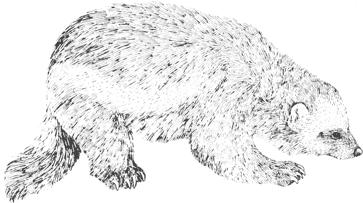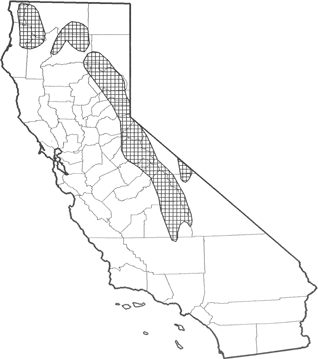
Wolverine
Distribution, Abundance, and Seasonality
A scarce resident of North Coast mountains and Sierra Nevada. Sightings range from Del Norte and Trinity cos. east through Siskiyou and Shasta cos., and south through Tulare Co. A few possible sightings occur in the north coastal region as far south as Lake Co. Habitat distribution in California is poorly known for the North Coast and northern Sierra Nevada. In north coastal areas, has been observed in Douglas-fir and mixed conifer habitats, and probably uses red fir, lodgepole, wet meadow, and montane riparian habitats. Most sightings in this region range from 500-1500 m (1600-4800 ft). In the northern Sierra Nevada, have been found in mixed conifer, red fir, and lodgepole habitats, and probably use subalpine conifer, alpine dwarf-shrub, wet meadow, and montane riparian habitats. Elevations in the northern Sierra Nevada mostly fall in the range of 1300-2300 m (4300-7300 ft). Habitats used in the southern Sierra Nevada include red fir, mixed conifer, lodgepole, subalpine conifer, alpine dwarf-shrub, barren, and probably wet meadows, montane chaparral, and Jeffrey pine. Elevations in the southern Sierra Nevada mostly are from 2000-3400 m (6400-10,800 ft). May travel extensively. There are indications that wolverines may be increasing in California (Grinnell et al. 1937, Ingles 1965, Yocom 1973, 1974, Johnson 1977, Schempf and White 1977, California Department of Fish and Game 1980a).

Range Map
Specific Habitat Requirements
Feeding: Feed primarily on small mammals and carrion (Grinnell et al. 1937, Ingles 1965, Hornocker and Hash 1981, Krott 1982). Prey includes marmots, ground squirrels, gophers, mice, deer carcasses, other vertebrates, berries, and insects. May kill large snowbound prey, but most large prey found by scavenging carrion. May drive bears or mountain lions from carcasses. Forage in open to sparse tree habitats on ground, in trees, burrows, among rocks, in or under snow, and sometimes in shallow water. May locate prey under deep snow. Cache food.
Cover: Prefer areas with low human disturbance. Use caves, hollows in cliffs, logs, rock outcrops, and burrows for cover, generally in denser forest stages.
Reproduction: Den in caves, cliffs, hollow logs, cavities in the ground, under rocks; may dig dens in snow, or use old beaver lodges (Thomas 1979).
Water: Must drink water.
Pattern: Hunt in more open areas, using dense cover for resting and reproduction.
Species Life History
Activity Patterns: Largely nocturnal, but may be active at any time of day. Active yearlong.
Seasonal Movements / Migration: Frequently travel long distances; may leave usual home range for many days. Travels may take them out of normal elevation and habitats.
Home Range: The yearly range in Montana was 422 km? (156 mi?) for males, and 388 km? (144 mi?) for females (Hornocker and Hash 1981). A hunting route circumscribed a range of about 2070 km? (800 mi?) (Gilbert 1970). Daily movements of up to 32 km (19.4 mi) occurred in Montana (Hornocker and Hash 1976), and can travel 10-15 km (6-9 mi) without rest (Nowak and Paradiso 1983). Distances between locations ranged from 5-133 km (3.1-81 mi) (Hornocker and Hash 1976). The size and shape of a home range is not affected by mountains, rivers, highways, or other major topographical features. Wide-ranging young males may colonize new ranges. Hornocker and Hash (1981) reported a density of 1/65 km? (25 mi?).
Territory: May be intolerant of one another, and scent mark their home ranges. Individuals of the same sex and yearlings may be driven out (Krott 1982), but there is much overlap between home ranges. Spacing is maintained in time, but not space (Hornocker and Hash 1981), thus territorial defense is infrequent. Several females may have home ranges within the range of a single male.
Reproduction: Probably polygamous, and mate from May to July. Active gestation is 30-40 days, but because of delayed implantation, full gestation period may last 215-272 days. The young are born from January through April. One litter/yr produced, averaging 3.5 (usually 2-4, ranging from 1-5). Young weaned in 7-9 wk, and sexually mature in second or third yr. Not all females reproduce each year (Wright and Rausch 1955, Rausch and Pearson 1972, Hornocker and Hash 1981, Nowak and Paradiso 1983). A captive individual lived 17 yr.
Niche: A predator and scavenger. It may benefit from the kills of mountain lions. Predation usually is not an important source of mortality, but in one study wolves preyed on wolverines (Krott 1982).
Comments: Have low population densities, even in best of range. Probably never common in California. Trapping, human disturbance, and grazing of high Sierra Nevada meadows have contributed to decline, a trend which may now be reversing (Schempf and White 1977).
Sources & References
California Department of Fish and Game, 1999.
California's Wildlife, Sacramento, CA.
Written by: V. Johnson, reviewed by: H. Shellhammer, edited by: J. Harris, R. Duke
California Department of Fish and Game. 1980a. At the crossroads: a report on the status of California's endangered and rare fish and wildlife. Sacramento. 149pp. Ewer, R. F. 1973. The carnivores. Cornell Univ. Press, Ithaca, NY. 494pp. Gilbert, B. 1970. The weasels. Pantheon Books, New York. 201pp. Grinnell, J., J. S. Dixon, and J. M. Linsdale. 1937. Fur-bearing mammals of California. 2 Vols. Univ. California Press, Berkeley. 777pp. Haley, D. 1975. Sleek and savage: North America's weasel family. Pacific Search Books, Seattle, WA. 128pp. Hornocker, M. G., and H. S. Hash. 1976. Ecology of the wolverine (Gulo gulo) in northwest Montana. Idaho Coop. Wildl. Res. Unit, Univ. Idaho, Moscow. 16pp. Hornocker, M. G., and H. S. Hash. 1981. Ecology of the wolverine (Gulo gulo) in northwestern Montana, USA. Can. J. Zool. 59:1286-1301. Ingles, L. G. 1965. Mammals of the Pacific states. Stanford Univ. Press, Stanford, CA. 506pp. Johnson, R. E. 1977. An historical analysis of wolverine abundance and distribution in Washington. Murrelet 58:13-16. Krott, P. 1960. Ways of the wolverine. Nat. Hist. 2:16-27. Krott, P. 1982. The glutton (Gulo gulo) in the ecosystem. Saeugetierkd Mitt 30:136-150. Nowak, R. M., and J. L. Paradiso. 1983. Walker's mammals of the world. 4th ed. 2 vols. John Hopkins Univ. Press, Baltimore, MD. 1362pp. Quick, H. F. 1953. Fisher and marten studies in a wilderness region. North Amer. Wildl. Conf. Trans. 18:513-532. Rausch, R. A., and A. M. Pearson. 1972. Notes on the wolverine in Alaska and the Yukon Territory. J. Wildl. Mange. 36:249-268. Schempf, P. F., and M. White. 1977. Status of six furbearer populations in the mountains of northern California. U.S. Dep. Agric., For. Serv., San Francisco, Calif. 51pp. Thomas, J. W., ed. 1979. Wildlife habitats in managed forests: the Blue Mountains of Oregon and Washington. USDA, For. Serv., Agric. Handb. No. 553. 512pp. Wilson, D. E. 1982. Wolverine. Pages 644-652 in J. A. Chapman and G. A. Feldhamer, eds. Wild mammals of North America. Johns Hopkins Univ. Press, Baltimore, MD. 1147pp. Wright, P. L., and R. A. Rausch. 1955. Reproduction in the wolverine. J. Mammal. 36:346- 355. Yocom, C. F. 1973. Wolverine records in Pacific coastal states and new records for northern California. Calif. Fish and Game 59:207-209. Yocom, C. F. 1974. Recent wolverine records in Washington and Oregon. Murrelet 55:15-18.
California Animal Facts | California's Wildlife